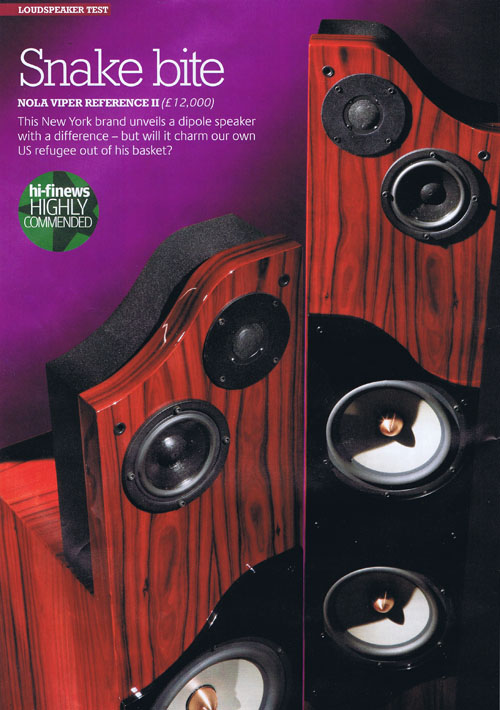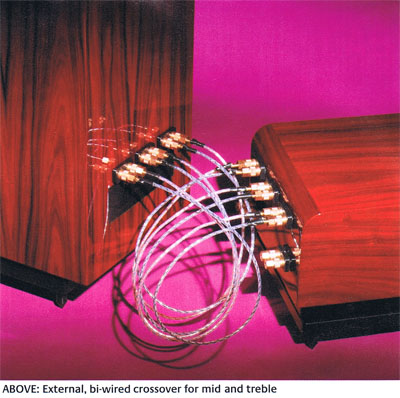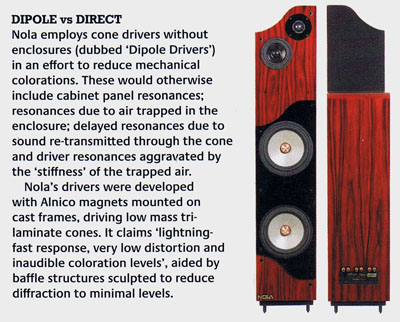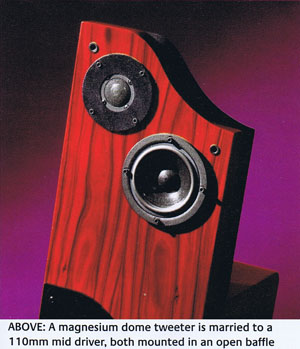
December 2008
Review: Ken Kessler
Lab Report: Keith Howard
 If you're torn between the sheer impact of speakers in boxes and
openness possible from panels, then your (hi-fi) life has inevitably
been a series of compromises. If you own pairs of each, you probably
swing between them, never quite satisfied - like owning solid-state
and valve amps. You know your Quad 57s lack the bass of, say, big B&Ws
or Tannoys. Conversely, you can't get the openness of the Quads or
Maggies out of your head. Nola appreciates this: its Viper Reference
II is in the middle of a series attempting to offer the best of both
worlds.
If you're torn between the sheer impact of speakers in boxes and
openness possible from panels, then your (hi-fi) life has inevitably
been a series of compromises. If you own pairs of each, you probably
swing between them, never quite satisfied - like owning solid-state
and valve amps. You know your Quad 57s lack the bass of, say, big B&Ws
or Tannoys. Conversely, you can't get the openness of the Quads or
Maggies out of your head. Nola appreciates this: its Viper Reference
II is in the middle of a series attempting to offer the best of both
worlds.
Nola isn't the first maker to attempt this: countless companies offer panel/cone woofer hybrids or dynamic speakers with mid/tweeters mounted independently from the main 'sealed box'. Nola follows the latter path, effectively eliminating the cabinet's effects above the upper bass by physically separating the mid and treble drivers from the woofers.
According to Carl Marchisotto, it's about avoiding the problems of 'trying to absorb the rear wave inside a small enclosure. In our design we use the whole listening room to absorb the rear wave in the mid and high frequencies - as the SPL from the back of the driver is exactly the same as in the front of the driver, and therefore cannot be fully absorbed by a rear chamber. What is not absorbed of the rear wave is then reflected back through the diaphragm after a small time delay and thus "smears" the direct sound, causing coloration.'
| 'It took the Kings' latest to reveal the Nolas way with fine detail, nuance and continuity' |
You must see the speaker to appreciate the way Nola deals with the
challenge. With dimensions of 46xl0x15in (hwd) and weighing 80 lb
each, the Viper Reference IIs are old-fashioned in that they are big
by today's downsizing standards but because they're so un-fussy - in
 my room they were 1m from each wall and firing straight ahead - they
needn't dominate the living space. What's inescapable are the looks:
you either love or hate that curvy top cut, mirror-imaged so the
speakers are left- and right handed. The rosewood finish is handsome
enough and if it doesn't suit your decor, piano black is an option.
my room they were 1m from each wall and firing straight ahead - they
needn't dominate the living space. What's inescapable are the looks:
you either love or hate that curvy top cut, mirror-imaged so the
speakers are left- and right handed. The rosewood finish is handsome
enough and if it doesn't suit your decor, piano black is an option.
A three-and-a-half way system, the driver complement consists of two 220mm cast frame magnesium cones in separate sealed chambers, below the open-baffle 110mm midrange and 25mm magnesium dome tweeter. You need to allow a bit of floor space for the external passive crossover, kept separate by Nola to reduce vibration and magnetically induced colourations. This is fed in bi-wire form to the main speaker; the crossover jumpers are made from Nordost Valhalla mono filament.
Supplied with the review pair were the optional IP1 Crossover Isolation Platforms, which sit below the speakers and crossovers. Designed as two-layer platforms with a ball-bearing suspension system between the upper an lower plates, they're said to further reduce coloration. These are an abject pain in the arse to use, the antithesis of rigid speaker mounting, but obsessive types wouldn't do without them.
LAMBORGHINI VS FERRARI
An easy load, the Vipers worked beautifully with the McIntosh
C2200/MC-2102 pre/power amp, connected variously with Kimber and Yter
wires. Sources included Marantz CD12/DAl2 and Musical Fidelity kW25 CD
players, and SME 30/Series V/Transfiguration for LP playback. Because
 the review pair had been run-in, the sound was ready-to-rock and
consistent throughout the review session: initial impact was slightly
restrained yet still impressive. Having recently heard the Magico H3,
which has the sort of command that I find in various Wilsons, I loved
the contrast from a similarly-priced/sized system. Though both are
decidedly thoroughbred, their presentation, attitude and experiences
were as different as Lamborghini vs Ferrari: similar class and
competence, but dissimilar enough to call on personal taste as the
final arbiter.
the review pair had been run-in, the sound was ready-to-rock and
consistent throughout the review session: initial impact was slightly
restrained yet still impressive. Having recently heard the Magico H3,
which has the sort of command that I find in various Wilsons, I loved
the contrast from a similarly-priced/sized system. Though both are
decidedly thoroughbred, their presentation, attitude and experiences
were as different as Lamborghini vs Ferrari: similar class and
competence, but dissimilar enough to call on personal taste as the
final arbiter.
Vocals were BBC-like in their naturalness and 'airiness', and that deliciously delicate instrument - the voice of the angelic Alison Krauss - sounded as sweet and dainty as it does through the Quad ESLs. Despite boasting a brace of woofers per side, the Nolas behave with utter finesse, their presence adding weight and extension without overpowering the upper frequencies. Somehow, Marchisotto has tamed, or should that be trained the woofers to do just what they need to do to fill out the sound. And - to these ears - that's a refreshing change, a nice whiff of retro listening preferences, when one considers how the trend has been toward ever more powerful, increasingly dominant bottom octaves.
OFF THE WALL
 This, of course, made spells with the heavy stuff more fun: would the
Nolas go all 'caveman' when asked? With no less than, appropriately,
'Brontosaurus' from the remastered edition of the Move's Looking On,
the Vipers were more than willing to pour out Stygian bass with
room-filling authority. That recording, however, hardly taxes a system
for anything other than bass quantity. It was the more precise and
complex lower registers of the Kings of Leon's 'Only By The Night',
overlaid with their off-the-wall rhythms and scary vocals that forced
the Nolas to open up and show what they could do.
This, of course, made spells with the heavy stuff more fun: would the
Nolas go all 'caveman' when asked? With no less than, appropriately,
'Brontosaurus' from the remastered edition of the Move's Looking On,
the Vipers were more than willing to pour out Stygian bass with
room-filling authority. That recording, however, hardly taxes a system
for anything other than bass quantity. It was the more precise and
complex lower registers of the Kings of Leon's 'Only By The Night',
overlaid with their off-the-wall rhythms and scary vocals that forced
the Nolas to open up and show what they could do.
However much the box/dipole topology works toward openness and superior soundstaging - which it does with flying colours - it took the Kings' latest to reveal the Nolas way with fine detail, nuance and continuity. If the inherent schizophrenia of a sealed woofer enclosure topped with an open mid/treble section suggests a possible threat to top-to-bottom cohesion, then Marchisotto has worked a brilliant sleight-of-ear: the Vipers' sonic continuity belies any break between bass and midband.